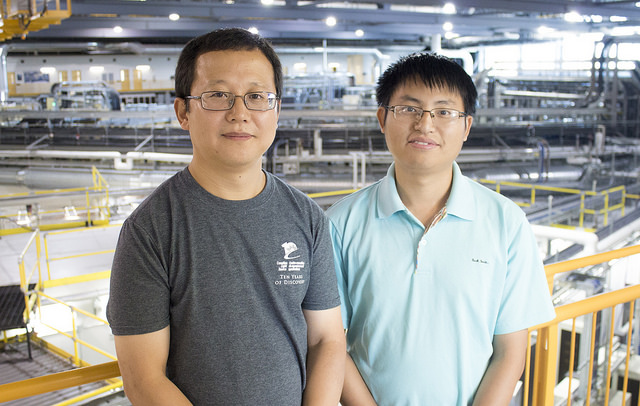Splitting water into hydrogen fuel
Synchrotron used to observe future renewable energy catalyst
In an era of increasing energy demands, scientists are searching for the holy grail of chemistry: a way to use renewable resources, like solar power, to split water into hydrogen fuel.
When hydrogen is used as a fuel, it leaves behind no pollutants or greenhouse glasses, only water.
Pioneers in the field use electrical energy to split water into its component parts: hydrogen and oxygen. Right now, it is an expensive process, with low net energy output. But with lower electronic barriers, hydrogen could replace petroleum as the vehicle fuel of choice.
Researchers hope to eventually produce hydrogen fuel with zero-emissions energy sources, like solar, mimicking photosynthesis and using existing CO2. But first, the water splitting process must be made more efficient.
Soochow University-Western University researcher Dr. Dongniu Wang and Canadian Light Source scientist Dr. Jigang Zhou are harnessing synchrotron techniques to rationally design a catalyst that could significantly reduce the energy that goes into water splitting.
 Wang says the search is on for a cheap, abundant, and high-efficiency catalyst to help along the water splitting reaction. In order to do so, researchers must understand what’s going on during the reaction, as well as the final results.
Wang says the search is on for a cheap, abundant, and high-efficiency catalyst to help along the water splitting reaction. In order to do so, researchers must understand what’s going on during the reaction, as well as the final results.
Without a synchrotron, it was possible to identify materials that improved water splitting efficiency but not how they helped along the reaction. And if researchers are going to design a catalyst to significantly lower the energy barrier for water splitting, they need to know not only what works well, but how it works.
By studying many phases of the chemistry in the water splitting process, the team identified that gamma nickel oxy hydroxide sped up the splitting faster than any other catalyst. The thing is, gamma nickel oxy hydroxide is created during the reaction from the nickel oxide that’s originally added.
“The only way to identify the active phase high efficiency catalyst is through synchrotron scans,” says Wang. “We are lucky at the CLS because we can use the whole range of X-ray to catch the whole transition process.”
Initial results are promising, pointing to highly-efficient catalytic candidates, but solar-powered water splitting is still a long way off. Zhou, however, believes that is exactly why this research is exciting.
“This is the true meaning of innovation. Not looking to present technologies but technologies far in our future.”
Cite:Wang, Dongniu, Jigang Zhou, Yongfeng Hu, Jinli Yang, Na Han, Yanguang Li, and Tsun-Kong Sham. "In situ X-ray Absorption Near Edge Structure Study of Advanced NiFe (OH) x Electrocatalyst on Carbon Paper for Water Oxidation. "The Journal of Physical Chemistry C (2015).






